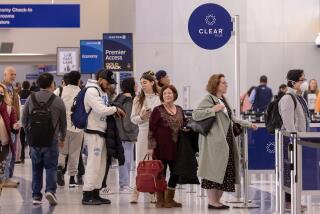Bill Would Upgrade U.S. Aviation System
WASHINGTON — The nation’s aviation system, straining to keep pace with increasing passenger and cargo loads, would get a record investment under a long-delayed bill that won Senate approval on a bipartisan vote Wednesday.
Federal spending on air traffic control, airport facilities and equipment and other aviation needs would jump from $10 billion this year to an average of more than $13 billion annually for the next three years under the legislation--with the biggest hike targeted for rebuilding and expanding aging airports.
In addition, airports would be allowed to raise passenger fees by as much as $1.50 per takeoff, up from the current $3 limit and the first such increase in a decade. That would generate another $700 million a year nationwide for airports to spend on adding terminals, sprucing up concourses or simply being good neighbors with an eye toward building political support for future expansions.
Los Angeles International Airport officials, for example, said that they would seek to raise their fee to capture millions of dollars of new revenue to help noise-reduction efforts in surrounding neighborhoods.
Aviation experts laud other provisions that would enable the Federal Aviation Administration to upgrade antiquated air traffic control systems--for example, by speeding the installation of systems to improve data transmission between cockpits and air traffic towers. But a signature element that appealed to lawmakers’ political instincts was an increase in federal grant money for improving local airport runways, taxiways and the like. Total spending for such projects would rise to $3.2 billion next year, up from $1.9 billion this year, drawing on a separate kitty of federal ticket tax revenue.
At San Francisco International Airport, the “airport improvement” entitlement is projected to double to $22 million, one of the nation’s largest, according to congressional staff. That could help with tarmac and runway repairs on a field that is often gridlocked when weather is bad.
LAX Has No Plans for Its Share
For most other airports, the available money would also double: Ontario International, for example, to $3 million; John Wayne Airport-Orange County, to $6.8 million; and Oxnard’s field in Ventura County, to $1 million. However, LAX has no plans to use a projected $16-million federal airport improvement allowance. Spokeswoman Nancy Castles said that the airport’s claim on the federal improvement funds is limited by its fiscal relationship to the city of Los Angeles.
The Senate approved the three-year, $40-billion bill on an 82-17 vote. Expected to win swift House passage and President Clinton’s signature, the bill is the first to retool FAA programs since 1996. It aims to do for the nation’s airways what a mammoth highway bill accomplished in 1998 for road users--redouble the federal commitment to improve transportation arteries that have helped fuel unprecedented economic growth.
That would seem a noncontroversial goal, given the habitual appetite in Congress for public works. But the aviation bill has been bottled up for more than a year by a duel on Capitol Hill between lawmakers who want to lock in a major ongoing investment in the nation’s heavily congested air transportation network and budget leaders who say that Congress needs to balance competing priorities.
In fact, the impasse put a halt last fall to federal airport construction grants. But all sides acknowledge that, with passenger loads in the United States expected to rise from about 650 million per year to nearly a billion in the next decade, the government can wait no longer. “We are hurtling toward gridlock and potential catastrophes in the sky,” said Rep. Bud Shuster (R-Pa.), a prime mover of the bill.
‘Money Must Be Spent,’ Democrat Argues
On Wednesday, Sen. John D. “Jay” Rockefeller IV (D-W.Va.) complained that the FAA is laboring with “equipment we’d be embarrassed to have in our own Senate offices. It is a crisis and so it is a priority. Money must be spent.”
But Sen. Frank R. Lautenberg (D-N.J.), an opponent, countered: “They’re saying: ‘Aviation proceed and the rest of the budget be damned.’ ”
Opposition also emerged from some lawmakers who represent regions near four of the nation’s busiest airports--Chicago’s O’Hare, Washington’s Reagan National and New York’s LaGuardia and Kennedy International--which are expected to draw more flights under a provision that would loosen federal restrictions on the numbers of daily takeoffs and landings.
In Chicago and New York, the restrictions are to be phased out in the next several years. At Reagan National, they will be eased significantly to allow more regional and cross-country flights--including flights from Arizona, the home state of Sen. John McCain, the Republican presidential candidate, who heads a Senate committee that oversees aviation.
Rep. Henry J. Hyde (R-Ill.), whose district includes the Chicago air hub, said that “more flights into an already jam-packed O’Hare will mean less time and distance between landing planes, shrinking down the margin for error for our overworked pilots, thus creating an ever-more-dangerous situation.”
Advocates reply that safety will remain a top priority. They said that easing the takeoff and landing limits would bolster competition in O’Hare and the other hubs that are dominated by major airlines, while improving service to underserved regions.
The Clinton administration lined up behind the bill.
“The whole bill is record-level for construction, safety and security across the board,” said Transportation Secretary Rodney Slater. “It’s definitely good for the American people.”
More to Read
Sign up for Essential California
The most important California stories and recommendations in your inbox every morning.
You may occasionally receive promotional content from the Los Angeles Times.










